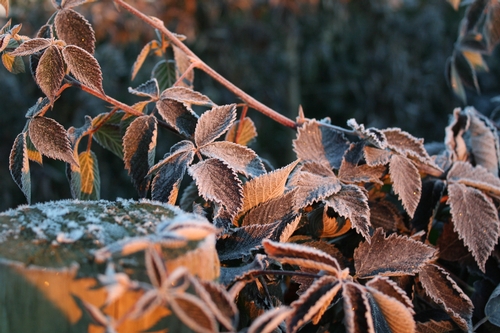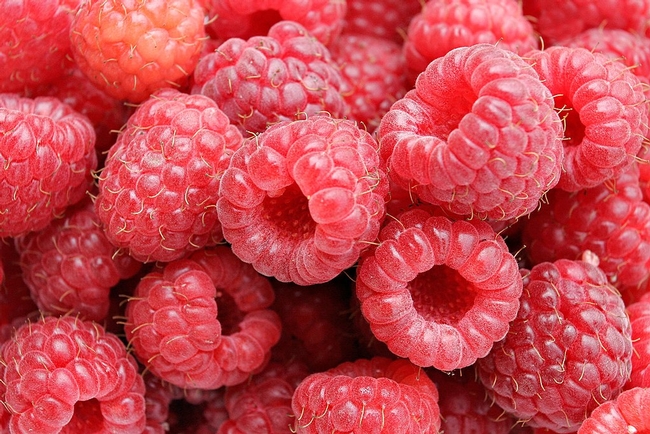
Posts Tagged: raspberries
Growers get help from UC in estimating raspberry production costs
When growers are considering a new crop to plant, and penciling out their expenses and income, cost estimates from the University of California may help. A new cost and return study for commercially producing raspberries released by UC ANR Agricultural Issues Center and UC Cooperative Extension includes an expanded section on labor.
Sample costs to establish, produce and harvest raspberries for fresh market in Santa Cruz, Monterey and San Benito counties are presented in “Sample Costs to Produce and Harvest Fresh Market Raspberries in the Central Coast Region – 2017.”
“The study focuses on the many complexities and costs of primocane raspberry production over a three-year period, including crop establishment, fertility practices, overhead tunnel management, harvest and rising labor costs," said Mark Bolda, UC Cooperative Extension farm advisor and co-author of the study.
The analysis is based upon a hypothetical well-managed farming operation using practices common to the region. The costs, materials, and practices shown in this study will not apply to all farms. Growers, UC Cooperative Extension farm advisors and other agricultural associates provided input and reviewed the methods and findings of the study.
“This raspberry cost and return study is the result of significant effort on the part of UC Cooperative Extension, the Agricultural Issues Center and several grower and industry collaborators, who shared their expertise and contributed mightily to the end product,” said Laura Tourte, UC Cooperative Extension farm management advisor and co-author of the study.
This study assumes a farm size of 45 contiguous acres of rented land. Raspberries are planted on 42 acres. The crop is hand-harvested and packed into 4.5-pound trays. There is a fall harvest during production year 1, a spring and fall harvest during production year 2, and a spring harvest during production year 3. Each harvest is three months long.
The authors describe the assumptions used to identify current costs for production material prices and yields. Tables show the phase-in schedules for California's minimum wage and overtime laws through the year 2022. Other tables show the monthly cash costs, the costs and returns per acre, hourly equipment costs, and the whole farm annual equipment, investment and business overhead costs.
Free copies of “Sample Costs to Produce and Harvest Fresh Market Raspberries in the Central Coast Region - 2017” can be downloaded from the UC Davis Department of Agricultural and Resource Economics website https://coststudies.ucdavis.edu. Sample cost of production studies for many other commodities are also available at the website.
The cost and returns studies program is funded by the UC Agricultural Issues Center and UC Cooperative Extension, both of which are part of the UC Division of Agriculture and Natural Resources, and the UC Davis Department of Agricultural and Resource Economics.
For additional information or an explanation of the calculations used in the studies, contact the UC Agricultural Issues Center at (530) 752-4651 or UC Cooperative Extension advisors Mark Bolda at (831) 763-8025 or Laura Tourte at (831) 763-8005 in Santa Cruz County.
Americans are Eating a lot More Berries
In case you didn't know this already, but Americans have really been eating a lot more berries than they used to. According the article linked below, raspberry consumption has increased 475% from 2000 to 2012, and consumption of strawberries is up 60% in the same timeframe.
Interestingly, since volume of fresh fruit consumed per person in the USA is basically flat in this 12 year period at 48 lbs per year, this means that berries are making up a increasing share of the total, with apples (down 9%), oranges (down 9%) and bananas (down 11%) taking the hit.
The best part of the article is the explanation of why this is happening. It says it's because berry farmers have figured out how to grow more berries and better berries.
Read the article, it's good:
Hoop houses sprouting along Santa Barbara County roadways
The "Roadside Attractions" column in the Santa Maria Times today comments on the increasing number of hoop houses seen along Santa Barbara County highways and byways.
Hoop houses, long white tents also known as tunnels, shelter raspberries, the article said.
“There’s been a dramatic increase in berry growing in the county,” said Mark Gaskell, UC Cooperative Extension advisor for San Luis Obispo and Santa Barbara counties.
Hoop houses essentially serve as mini-greenhouses. Made of plastic stretched over hoops, they control heat and humidity and shelter plants from wind.

Hoop houses help growers regulate the raspberry ripening process so the delicate fruit can reach markets at an opportune time.
Understanding Chill for Berries in California
The cold weather we have been experiencing over the past few days has prompted a lot of talk and even articles in the popular press over what the effect of this cold would be to local berry growers. Beyond the damage that very cold temperatures could cause tender plant parts such as flowers and emerging vegetative parts (of which we fortunately don’t have very many right now), the question worth exploring is what benefit this weather could be bringing to our berry crops.
Many of our cultivated fruiting plants originate from temperate regions, including many berry species and tree fruits, and as such go dormant in response to oncoming cold weather in the autumn. This adaptation of dormancy protects the plant buds from injury when temperatures fall below freezing and the buds stay this way until enough cold has been accumulated over time.
This accumulation of cold over time, known as chilling requirement and measured in hours as chill units, is the minimum amount of cold after which many fruit trees, caneberries and strawberries need to be exposed to in order to grow properly in the following spring. The total number of hours of chill needed to establish proper flowering and vegetative growth vary substantially for plant types and even between varieties of the same plant species.
If plants requiring a certain amount of chill hours do not receive it, they may end up blooming or leafing out late in the spring or in an spread out, uneven fashion. Additionally, they may subsequently experience reduced fruit production and quality.
Another complication of calculating chill units in California, as compared to much colder regions of the country, for example Wisconsin where temperatures can be below freezing for weeks at a time (go Badgers!), is that our region tends to have a cycling of warm and cold weather throughout the winter. How then do we as agriculturalists in California calculate chill accumulation in this back and forth between cold and warm?
To calculate chill hours, there are three common models all based on the principle that plants accumulate chill between 45 degrees F and freezing (32 degrees F and not below). One model ignores the below freezing threshold and simply calculates total number of hours under 45 degrees F, another calculates number of hours between 32 degrees and 45 degrees, and another, called the Utah model, is bounded by 34 degrees and 45 degrees but also accounts for negative chill accumulation, being the understanding that temperatures above 61 degrees detract from chill hours already accumulated. It is worth pointing out that in the Utah model, temperatures under 34 degrees do not accumulate chill, nor do they detract from it.
Yet, the fluctuating temperatures of California still are a challenge to some degree for these models, and the University of California is engaged in research to get a better handle on these conditions, and is has been testing a “Dynamic Chill Model” and a “Chill Portion Model”. Both of these are beyond the scope of this blog, but Central Coast agriculturalists seeking to further their understanding about chill and how to manage it, will find an excellent resource at :
http://fruitsandnuts.ucdavis.edu/Weather_Services/chilling_accumulation_models/

7:15 am, January 13, 2013. Temperature 25 degrees F. Good morning Watsonville!

Blackberry leaves covered in frost - plus or minus benefit to the plant?

This frost covered blackberry flower will unfortunately not make it to fruiting.
New UC studies examine cost of producing beef, alfalfa hay, corn silage, rice, prunes, raspberries and avocados

Each analysis is based upon hypothetical farm operations using practices common in the region. Input and reviews were provided by farm advisors, researchers, growers, farm accountants, pest control advisers, consultants and other agricultural associates.
Assumptions used to identify current costs for the individual crops, material inputs, cash and non-cash overhead are described. A ranging analysis table shows profits over a range of prices and yields. Other tables show the monthly cash costs, the costs and returns per acre, hourly equipment costs, and the whole farm annual equipment, investment, and business overhead costs.
The new studies are:
Sample Costs for Finishing Beef Cattle on Grass, 2012, Sacramento Valley, by Larry C. Forero, Roger S. Ingram, Glenn A. Nader, Karen M. Klonsky, and Richard L. De Moura.
Sample Costs to Produce Corn Silage, 2012, San Joaquin Valley by Carol A. Frate, Brian H. Marsh, Karen M. Klonsky, and Richard L. De Moura.
Sample Costs to Produce Rice, 2012, Sacramento Valley by Christopher A. Greer, Randall G. Mutters, Luis A. Espino, Paul Buttner, Karen M. Klonsky, Richard L. De Moura and Kabir P. Tumber.
Sample Costs to Establish a Prune Orchard and Produce Prunes, 2012, Sacramento Valley by Richard P. Buchner, Joseph H. Connell, Franz J. Niederholzer, Carolyn J. DeBuse, Karen M. Klonsky, and Richard L. De Moura.
Sample Costs to Produce Fresh Market Raspberries, 2012, Central Coast by Mark Bolda, Laura Tourte, Karen M. Klonsky, and Richard L. De Moura.
Avocado Sample Establishment and Production Costs and Profitability Analysis for Ventura, Santa Barbara and San Luis Obispo Counties, 2011, Conventional Production Practices and Avocado Sample Establishment and Production Costs and Profitability Analysis for San Diego and Riverside Counties, 2011. Conventional Production Practices by Etaferahu Takele, Gary Bender and Mao Vue.
Avocado Sample Establishment and Production Costs and Profitability Analysis for Ventura, Santa Barbara and San Luis Obispo Counties, 2011, Organic Production Practices and Avocado Sample Establishment and Production Costs and Profitability Analysis for San Diego and Riverside Counties, 2011, Organic Production Practices by Etaferahu Takele, Gary Bender and Mao Vue.
All cost of production studies are available online at http://coststudies.ucdavis.edu, at UC Cooperative Extension offices or by calling (530) 752-3589. For additional information on the studies, contact Richard De Moura at rdemoura@ucdavis.edu in the UC Davis Department of Agricultural and Resource Economics.

